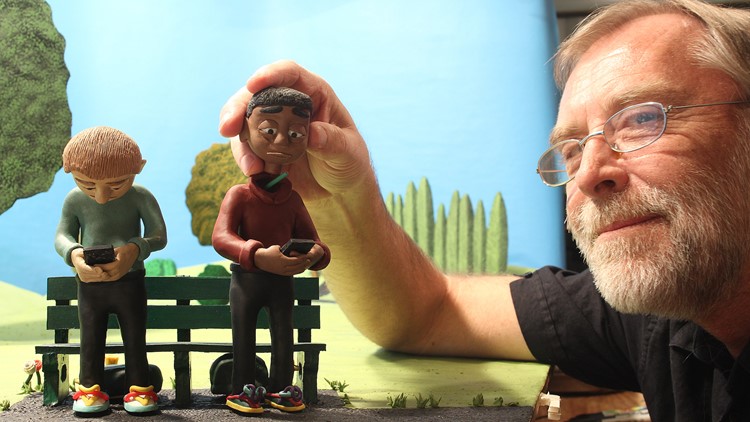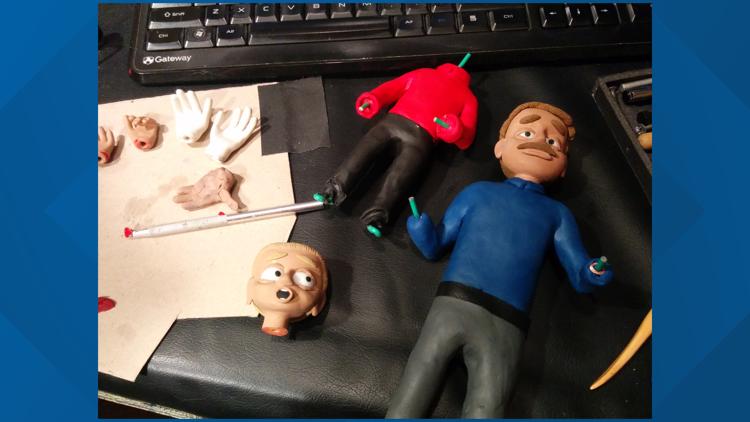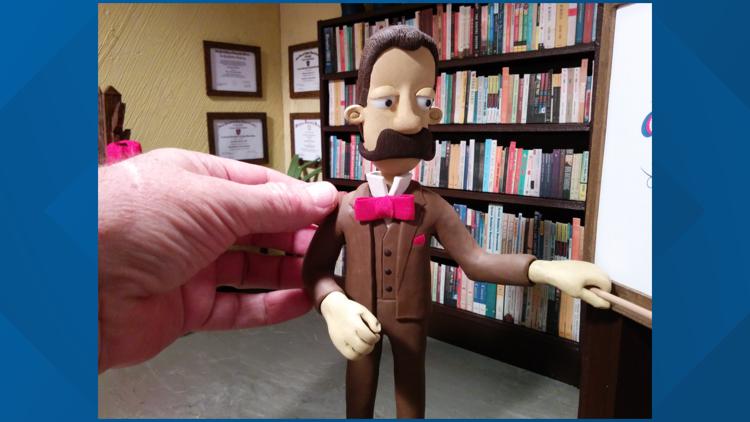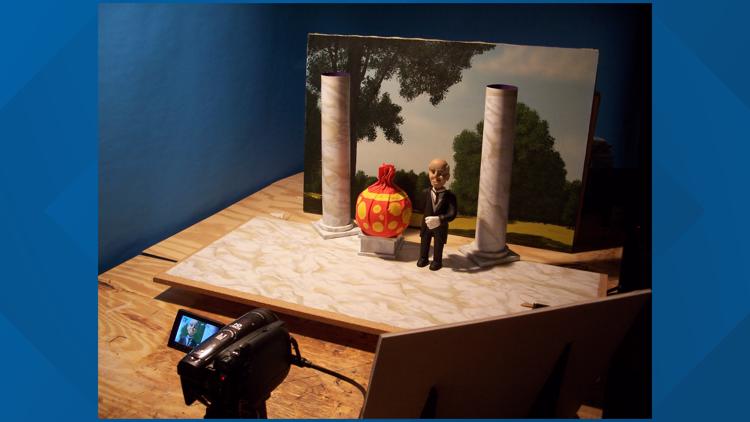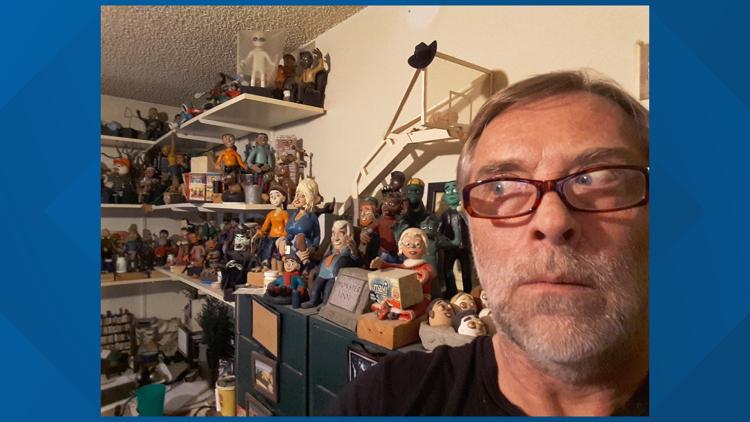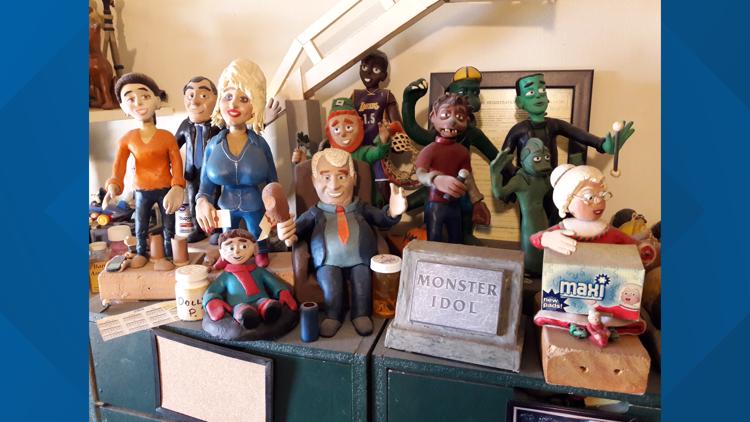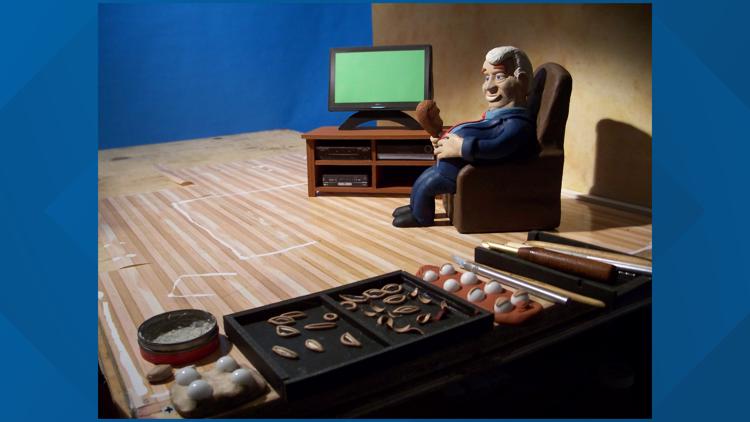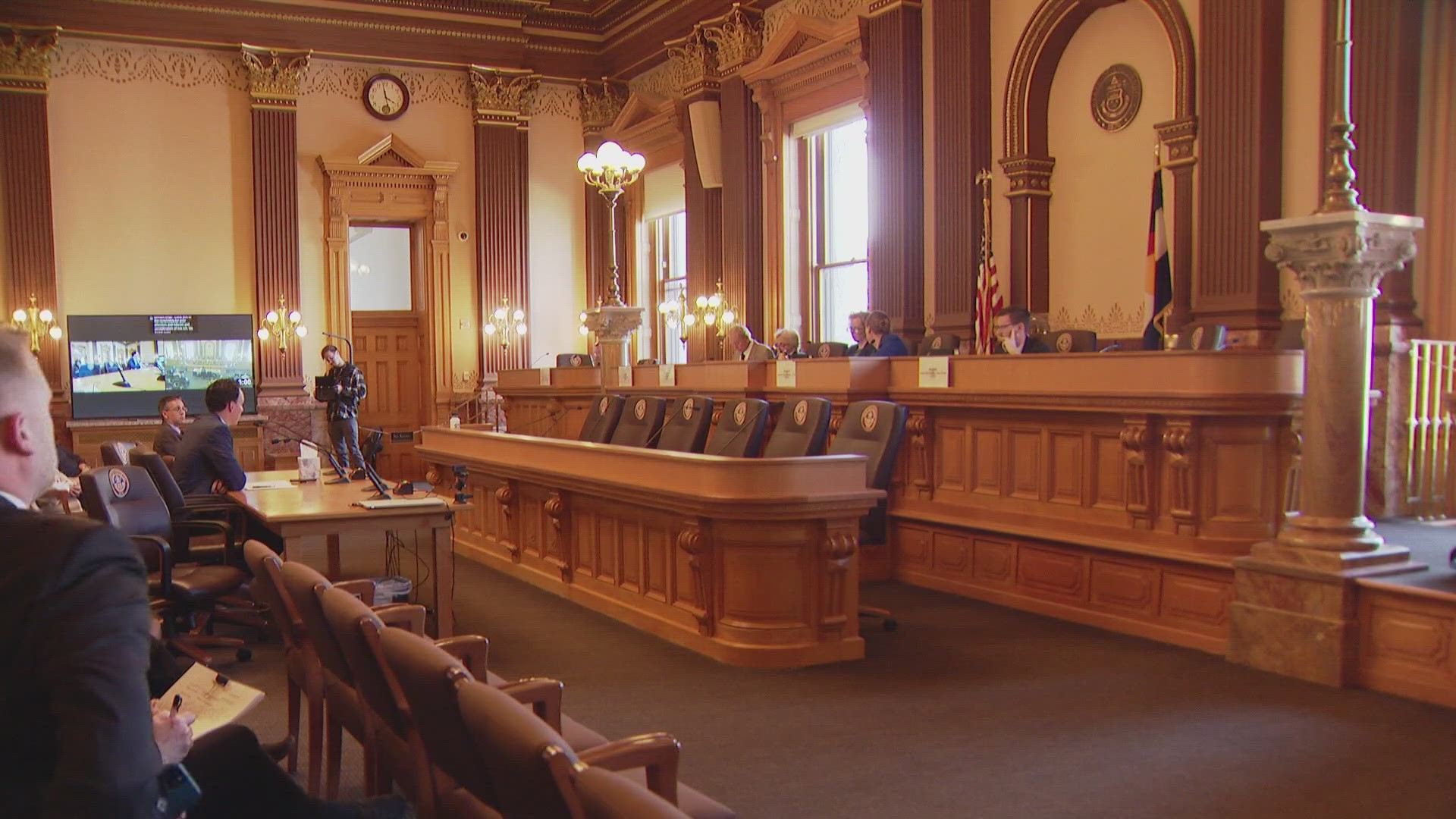DENVER — Randy Boyum has been playing with clay for more than 40 years.
"I dabbled in clay animation as a 12-year-old in the mid-1970’s, producing a few truly horrible short films," Boyum, now 58, said.
After a decades-long career in clay animation, the Denver resident said he's using this downtime (that many of us are experiencing right now) to finish his latest short film and to clean his studio – Boyum said some things have been on shelves for 15-20 years.
"After that, I may shoot some short-shorts with the new characters from my latest film," he said. "Unless a new client calls. But it’s been three years since I’ve had one, and I’m fine with that!"
>> This story is part of a web series about Coloradans doing cool things. If you know someone who should be featured, email dacia.johnson@9news.com.
If you've seen movies such as “The Nightmare Before Christmas,” “James and the Giant Peach,” or “Chicken Run,” then you've seen clay animation. Even "The Gumby Show" which ran on NBC from 1955-1968, was clay animation. The art actually dates back to 1897.
I chatted with Boyum to learn more about clay animation, the time it takes to make a 3-minute film (hint: a long time!) and what a career in the field looks like.
I must also mention, Boyum has a great voice – one of the memorable announcer or narrator voices, so make sure to give some of his videos a listen.
And Boyum's answer to how he got into his craft is pretty long but also fascinating because his passion is very obvious. So just keep reading!
(Editor's Note: This interview has been edited for context and clarity)
How did you get into clay animation?
Boyum: In 1989 I got my hands on a Super 8mm movie camera and, just for fun I started playing with clay animation again after dabbling in it when I was 12.
In the fall of ‘89, my mother, who lived in Denver at the time and had seen – and painfully grinned at - my small attempts to create 3-minute clay epics, called me one day in a panic and said, “Turn on NBC!” I scrambled to the TV and caught a story about a local company called Lost Leader Productions that did professional clay animation. I was floored and totally amazed that such a company existed in Denver.
I tracked them down and showed them my meager reel of Super 8 nonsense – and we hit it off. So I started helping them to produce their 30-minute collection of ten clay animation short films called "Classics in Clay." At first, I just did simple tasks, but eventually, I got to sculpt characters and animate on a couple of films. The budget was very low and I was not paid but received small ownership in the project. And that was totally fine.
In 1992, work began on a music video called "Jamaica, No Problem" by a local Denver band called Burnt Lips.
I helped out at Lost Leader during my spare time in the evening and on weekends but had to have a real job to pay the bills. In 1991 I became the video production manager for Image Audiovisuals in Denver where I wrote, produced, directed and edited corporate video productions and live events.
Then in 1999, I happened to spot an ad looking for animators to work on a new prime-time sitcom that was being shot in stop-motion. It was called "Gary and Mike" and was about a couple of goofy 20-something guys going on a road trip across America.
Just a few days later I came home to find a message on my answering machine. A kind woman’s voice simply said, “Hi. My name is Lori Kingston. I’m with Will Vinton Studios. Could you please call us at your earliest convenience?”
I had to take a few minutes to calm down from all the screaming, which I’m sure totally unnerved my neighbors, and I listened to the message a dozen times. Then I finally took a deep breath and picked up the phone. An angelic voice belonging to Lori Kingston, the recruiter for the studio, answered the phone. I said, “This is Randy Boyum, returning your call.”
There was a very long pause. Then the first words out of her mouth were, “Why aren’t you already working here?”
In June of 1999, I quit my job at Image Audiovisuals, packed up my car, and left Denver to work a six-month contract at Will Vinton Studios as an animator.
It was absolutely the most amazing experience I have ever had. A group of about 100 artists all gathered in a nondescript warehouse in Portland to create a bunch of magic in the form of six 22-minute episodes. I was one of 20 animators. The rest of the crew were puppet sculptors and fabricators, carpenters and painters, set designers and prop makers, lighting and camera pros, producers and directors, and the benevolent office people who kept things rolling right along.
In January 2000, I started Random Animation, my home clay animation studio in Denver, after I was asked to make a short film about a “board room meeting gone horribly wrong.”
It took me about four months to build the set, sculpt the ten characters and shoot the two-minute film. It aired at a conference of doctors ... and I also happened to be running the camera in the back of the room, so I got to see the audience reaction. They loved it and applauded wildly. It was wonderful and so gratifying and I was absolutely floored by the experience."
Just after finishing that film, I was asked to make a film with a dozen eggs singing the jingle for Le Peep, a restaurant chain.
So that was my second project. It took about three weeks to build the twelve eggs and although the whole thing was only six seconds long, it took me over 20 hours to animate the twelve faces all singing together.
Suffice it to say that in the past 20 years I’ve created 12 short films, 15 commercials, 17 animated greeting cards, a music video, and 8 corporate projects that were used in various ways for business meetings, conferences and churches.
For a 2-3 minute film, how long does it take to produce?
Boyum: That varies wildly, first depending on the number of sets I have to build and characters I have to sculpt. Then it depends on what those characters are doing.
If it’s just a couple guys chatting on one set, it goes much quicker than shooting an action scene like dancing, fighting, running, kayaking, etc. I’ve created a 3-minute film in about three months – but I’ve also needed a year to shoot a 3-minute film.
Can you walk us through your creative process?
Boyum: If it’s for a client, we discuss their script, and usually, they will provide me with a finished soundtrack, which you always need to have first so you can time out the animation to the audio. Then I sculpt the characters and when they are done and approved by the client, I build the sets. When those are approved I begin the animation.
If I’m doing my own film, I have an “aha” moment when I get the right idea. Then I write the script, and follow the same process: Record the soundtrack, sculpt the puppets, build the sets, then I animate. Plus, on many of my films, I also compose the background music, which usually comes at the end unless it’s integral to the story.
What’s the hardest part of making the film?
Boyum: The animation is the most difficult. Sculpting and set construction are fun and relaxing while you work. You can take your time to get it right. But when animating, you often get into tricky situations that can take hours to shoot just one frame. And whenever possible, you try to nail the movements of the characters so you don’t have to back up and reshoot frames. That is something I have to do occasionally, but with the use of a frame grabber, I can immediately see what I’m doing and can usually tell fairly quickly if things are going wrong.
What’s your favorite part of making the film?
Boyum: Shooting the last frame is always a joyful experience – especially when you’ve been working on the same project for a year.
Where do your ideas come from?
Boyum: Anywhere and everywhere. My brain has always got strange things bouncing around in it. The idea for my newest film hit me while I was driving on a beautiful, spring day last year. The sun was shining and the skies were clear and stunning. While waiting at a stoplight I spotted a young man standing on the corner, waiting for the light to change. But he wasn’t taking in the glory of the day. He was staring at his phone. And when the light changed, he crossed the street without even looking up. That goes on everywhere, always, and it totally creeps me out. My new film addresses that idea – and takes it to the extreme.
What about your behind-the-scene video?
Boyum: Many people post reels of their animation, showing brief clips in a compilation of their work. But my animations are already posted in complete form on my channel. So I thought it would be fun to create a video that shows all the sets I have created over the years. When I finished it, I was surprised by how many different locations I had built in one small room.
Where do you keep your sets?
Boyum: When I finish a project, I take down the walls and store them in a flat stack in a closet, which is getting quite full. But props and furniture items are crammed onto my overflowing shelves or they are carefully placed in boxes for storage – of which I have many. On rare occasions, I’ve been able to reuse some pieces of furniture – most especially miniature paintings. To avoid copyright issues I use small photos of my own landscape paintings - with a clay frame - in my sets, and I have often used them in more than one project.
Can you reuse clay?
Boyum: You can reuse soft clay, if you’d like. It’s oil-based and stays soft forever (Plasticine – from hobby shops). I have characters I made over 30 years ago that are still soft and moveable. I occasionally reuse some clay, but for the most part, I just buy new clay It’s inexpensive and I love the smell of fresh clay in the morning!
How much clay do you go through?
Boyum: Clay comes in one-pound blocks. I used the most clay ever for "Rudolph Revisited" – a spoof of the classic Rudolph that I made for Larry the Cable Guy in 2007 – which took about 20 pounds of white just to build the snowy set. Plus several more pounds for the seven characters I sculpted. But for most projects, I don’t need that much, maybe three to five pounds, in varying colors.
(Warning: viewer discretion advised in video below)
What are the hardest things to make?
Boyum: My tallest characters are about 8-9 inches in height. Miniature objects that need to be held by the tiny hands of those puppets can be very tricky to sculpt, especially as I’ve gotten older and can’t see as well as I could in my youth.
Tell us more about the building process
Boyum: My clay characters are sculpted over wire armatures. Their bodies are soft clay so they can be moved around. The heads are made with hard-baked clay (Sculpey) so the character’s face stays clean and doesn’t change shape while working with it. (Soft clay gets dusty and is difficult to clean)
The eyes are white marbles. The eyelids, eyebrows, pupils and replaceable mouths on the face are also hard-baked and are stuck on using a tiny bit of wax. The hands are made with hard-bake clay that isn’t baked – so they can be animated – until the hand needs to pick up an object, which can then be glued to the hand after baking. If the object is set down, I replace the hard hands with another set of soft ones to continue animating.
If a character needs to leave the ground, like when jumping or flying, etc. they must be hung or supported using a wire or other structure known as a “rig.”
Then the rig needs to be removed from the shot by having a blank background (a shot of the scene without the character in it) that you put behind the shot with the rig. You just erase the rig revealing the blank shot behind where there is no wire. Then you have a clean frame with the character in mid-air, magically “floating” without visible support.
Clay animation with Randy Boyum
What’s something about clay animation people are surprised to know?
Boyum: Despite its apparent stickiness, clay does not naturally stretch. So, for example, when you raise a character’s arms, it rips apart and leaves holes under the arms (photo below) that the animator has to then repair – on most every large move.


What’s a favorite film you’ve made?
Boyum: My new favorite is the five-minute film I just finished. I have not even released the title of it yet, and literally no one has seen it. And it may be a while before I post it on my channel because I am submitting it to film festivals, which is a very long process and they often don’t accept films that anyone can see on YouTube.
Another favorite film that I’ve made for myself, just for fun, is Blue Jays – which, oddly, contains no clay. It’s the only stop-motion film I’ve done using paper, and shot in silhouette. But it took over a year to make that one because of the complexity of the script and the music.
Boyum: I think my favorite clay videos that I’ve created are the animated greeting cards. They are short and have good punchlines.
I’m rather partial to “How To Make A Giant Book”, which also contains no clay, and is an actual “How To” video where you can learn how to make a giant book. I really enjoyed writing the music for that one. It was based on my experience of making a giant book for a church.
What else would you like to share?
Boyum: Many animators out there like to create crude, obnoxious videos with lots of swearing, blood, guts and/or obscene violence. Those videos seem to get a lot more attention than the type of entertainment I prefer to create. I could jump on the bandwagon and make vulgar videos that might get me more views, but I choose to embrace more wholesome values that are fun for all ages to enjoy.
SUGGESTED VIDEOS | Feature stories from 9NEWS


